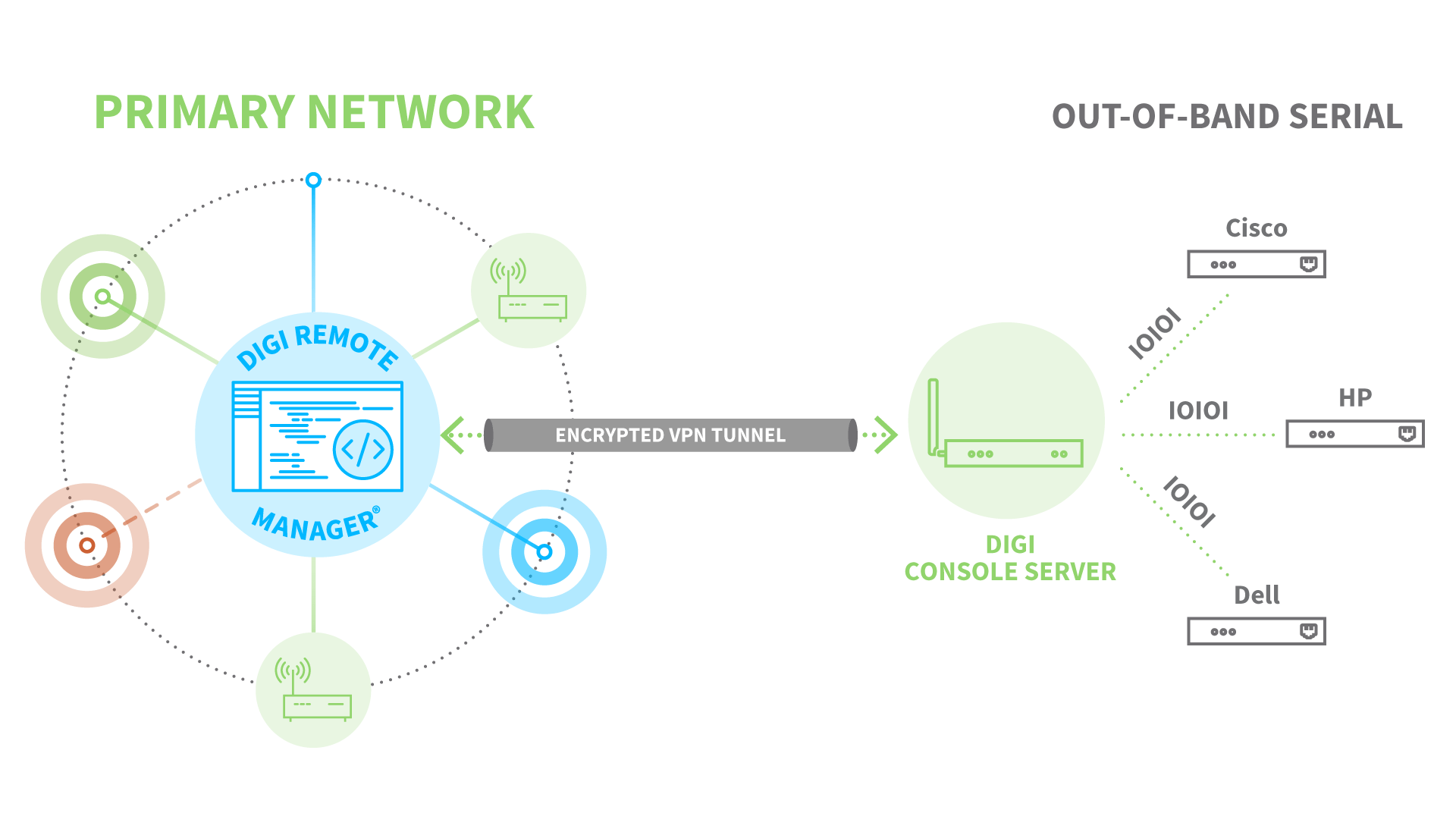Overcome Network Outages and Disruptions with Back-up Connectivity
When a network goes down, or a remote device goes offline, IT administrators need a way to connect to field hardware and restore normal operation. The best way to do that is with secure out-of-band management.
What Is Out-of-Band Management?
Out-of-band (OOB) management is a method of remotely controlling and managing critical IT assets and network equipment using a secure connection through a secondary interface that is physically separate from the primary network connection. This enables administrators to gain control even during infrastructure faults.
Digi solutions enable out-of-band (OOB) management and network resilience for a range of use cases
Digi offers a number of Out-of-Band solutions, including Opengear's Network Resilience Platform - featuring Smart OOB™ management and NetOps Console Servers - and a full range of Digi console servers and routers together with Digi Remote Manager®:
How Does Out-of-Band Management Work?
Out-of-band management is typically enabled through a serial console port, such as RS-232, which provides a command line interface for troubleshooting routers, servers, switches, power controllers, storage devices and other equipment. This enables administrators to configure, reboot, and reset devices if the primary network becomes unavailable.
Out-of-band management is especially useful for IT teams that need to manage large numbers of locations at scale, where physical access to each individual device is nearly impossible. This technology serves as a valuable component of any network disaster recovery plan. As networks are increasingly distributed, the need for out-of-band management is even more important.
Out-of-Band Data Center Management
Critical IT assets are found across all modern enterprises, including traditional data center, regional distribution centers and branch locations. While the scenario is constant, the major variable is the number of devices at each location. Larger locations often have redundant wireline WAN connections; the ability to reach these locations can be severely compromised in the case of a network incident. Cellular connectivity in every location ensures the greatest chance for rapid recovery.
Remote Site Resilient Network Management
Several factors distinguish the most effective approach to out-of-band management. One of these is wireless connectivity. Many organizations provide back-up for primary copper or fiber connections with a secondary wired line to regional distribution centers and branch locations. However, back-up lines can be vulnerable to the same hazards that can affect a primary wired line.
The lines share the same conduits and may even connect to the same service providers. Wireless technologies bypass much of the wireline infrastructure, making wireless a more reliable choice for connectivity. In addition, with a cellular connection in pass-through mode, there’s no need to replace an existing router, firewall or SD-WAN appliance.
Wireless technologies bypass the wireline infrastructure, making wireless a more reliable choice for connectivity. In addition, with a cellular connection in pass-through mode, there’s no need to replace an existing router, firewall or SD-WAN appliance.
With wireless out-of-band management in place, most device failures can be effectively addressed by a remote connection, avoiding costly onsite visits by service technicians. Meanwhile, cellular failover maintains seamless connectivity with critical equipment when the primary network is offline, minimizing downtime.

Control at the Network Edge
Networks are increasingly deploying IT infrastructure in remote locations. As data is collected closer to its source, there’s a greater need to monitor and manage the equipment from a central location. Troubleshooting and remediation at the edge, through the use of out-of-band management, empowers administrators to address problems quickly, before they result in a catastrophic network failure.
Managing Infrastructure from Anywhere
The flexibility to access and manage devices from anywhere is a fundamental capability of out-of-band management. Digi console servers, such as Digi Connect® IT 4 and Opengear Resilience Gateways, help enable continuous network uptime by functioning as an always-on cellular out-of-band gateway in remote locations such as branch offices, kiosks, retail stores and distributed infrastructure.
In addition, Digi Remote Manager — Digi’s centralized security and management platform — provides a unique form of out-of-band management through its integrated console terminal. Administrators can perform out-of-band management with virtually any enterprise hardware through a serial connection using a combination of Remote Manager and Digi cellular products running the Digi Accelerated Linux (DAL) operating system. Digi Remote Manager allows devices to avoid using static IP addresses, providing greater security and management flexibility. An SMS emergency recovery mechanism enables administrators to reboot remote Digi devices even if they aren't currently transmitting TCP/IP data.

When using a console server from the Digi Connect IT family for out-of-band management through Digi Remote Manager, the architecture looks similar to the diagram above.
For Businesses that Demand Always-on Connectivity
For administrators managing critical IT infrastructure in remote locations, 24/7 connectivity is a business necessity. But connectivity can be impacted by many things, from weather events, to configuration failures, to human error, or even distributed denial-of-service (DDoS) attacks. Whatever the cause, an unplanned outage that disrupts the ability to manage and run a business is costly. Out-of-band management is a requirement for every network manager’s toolkit.